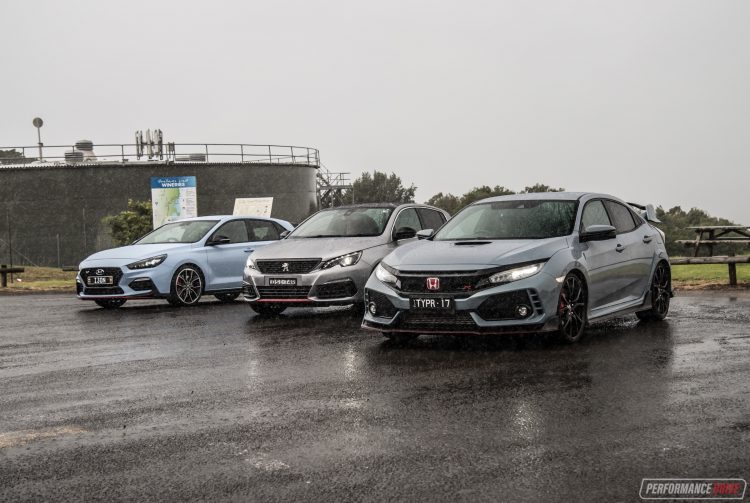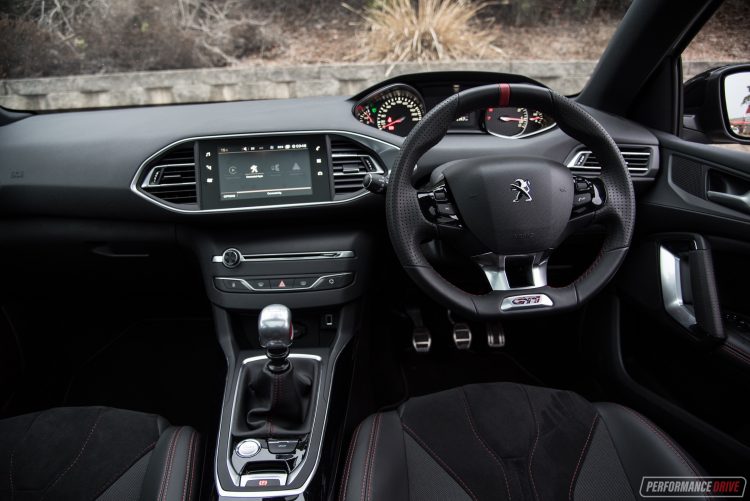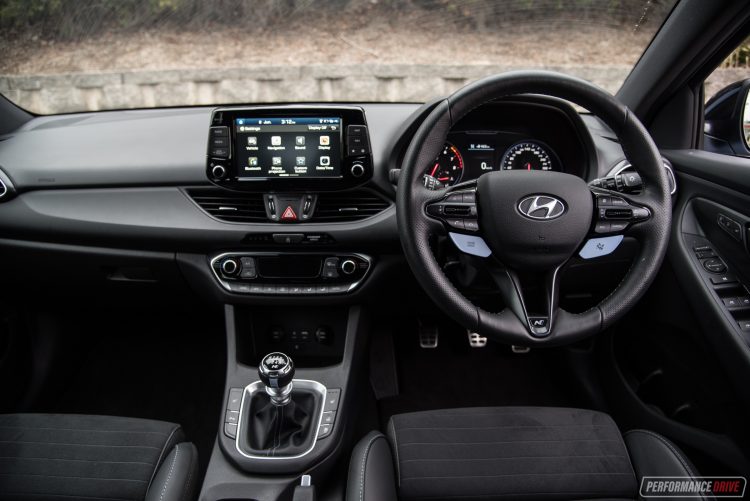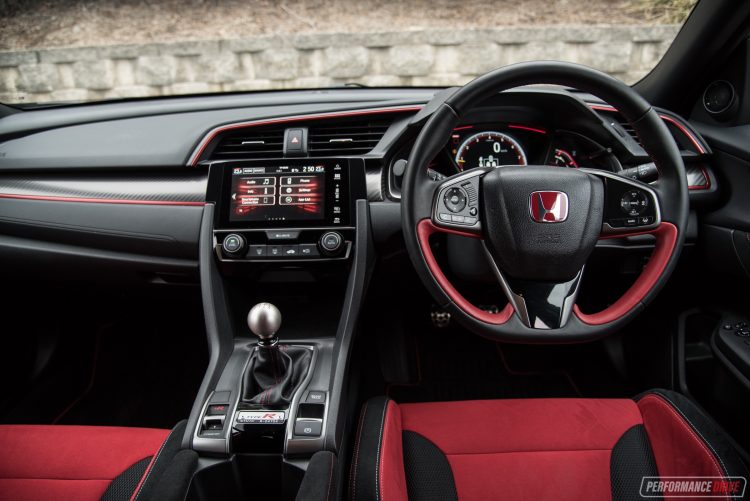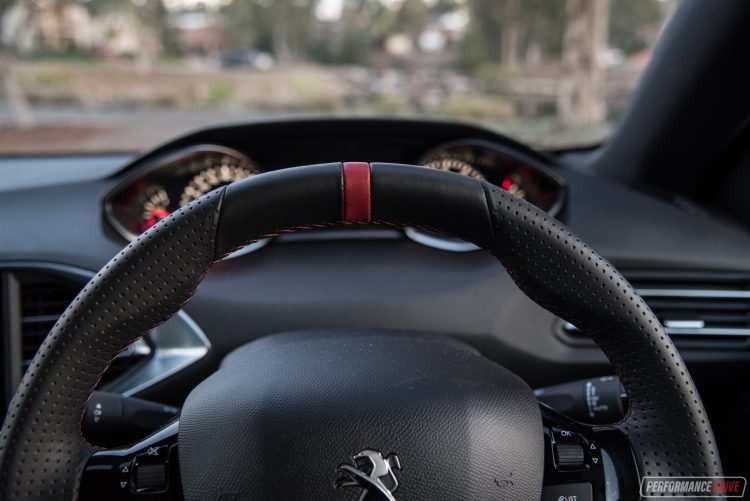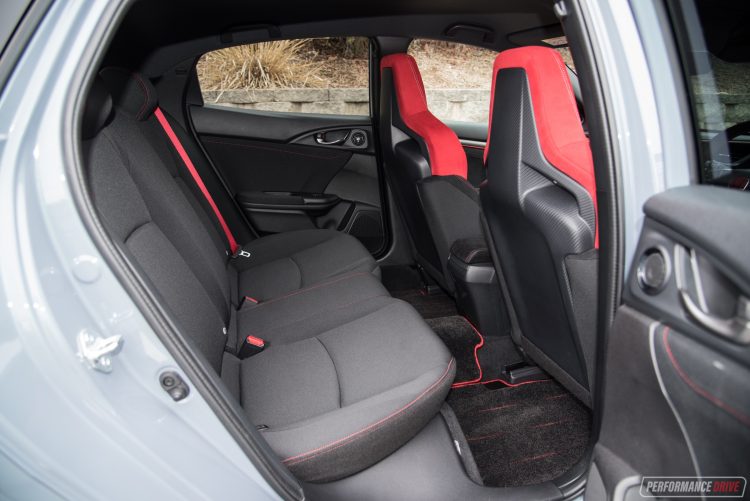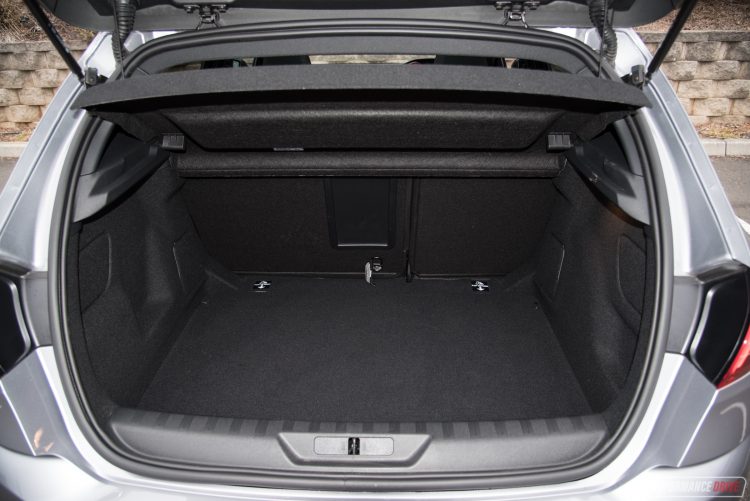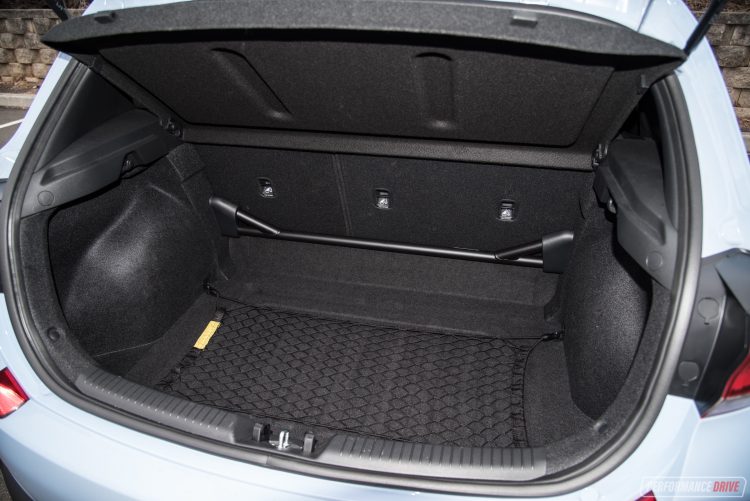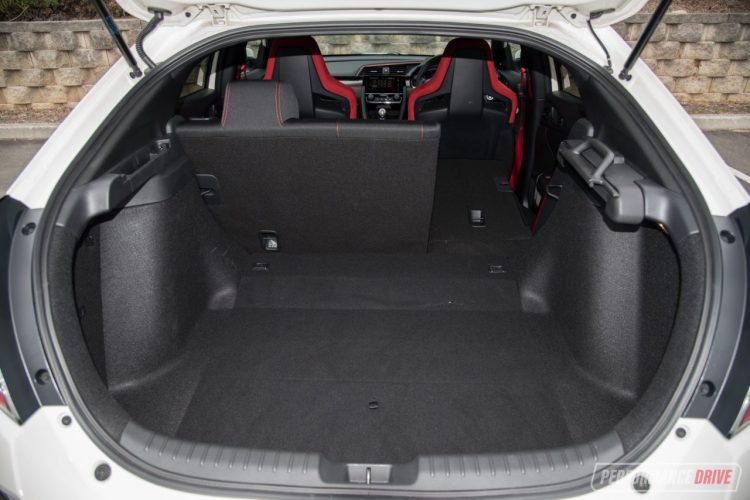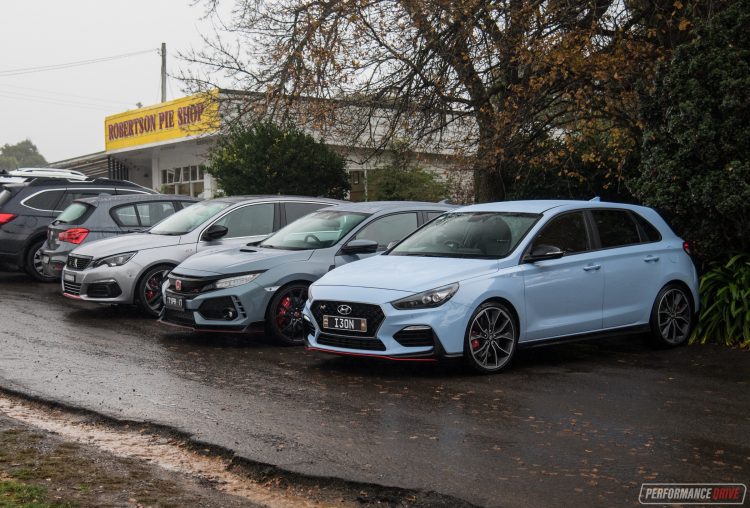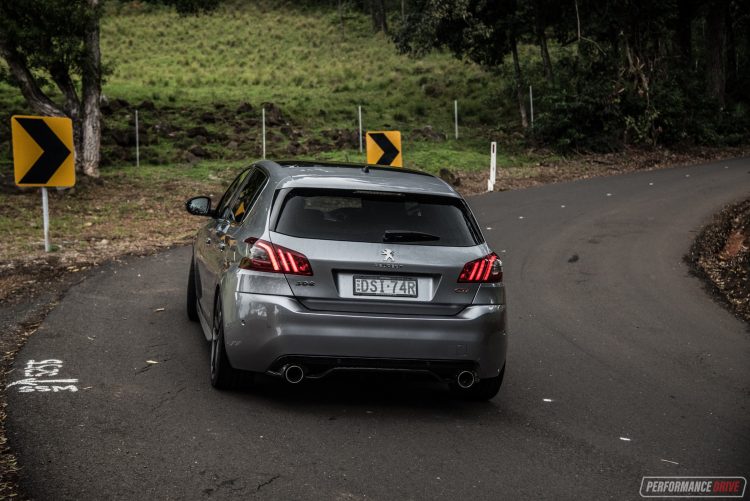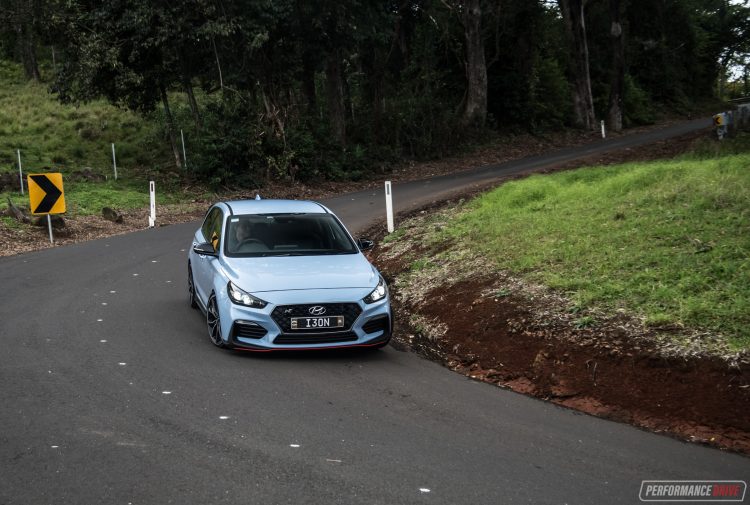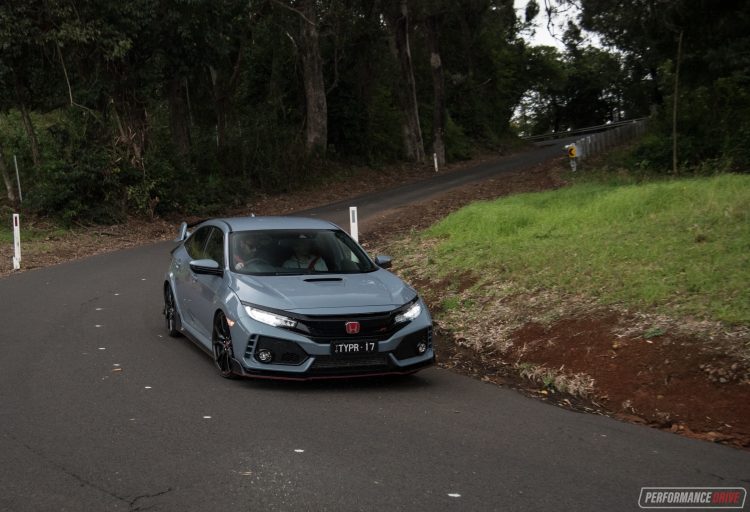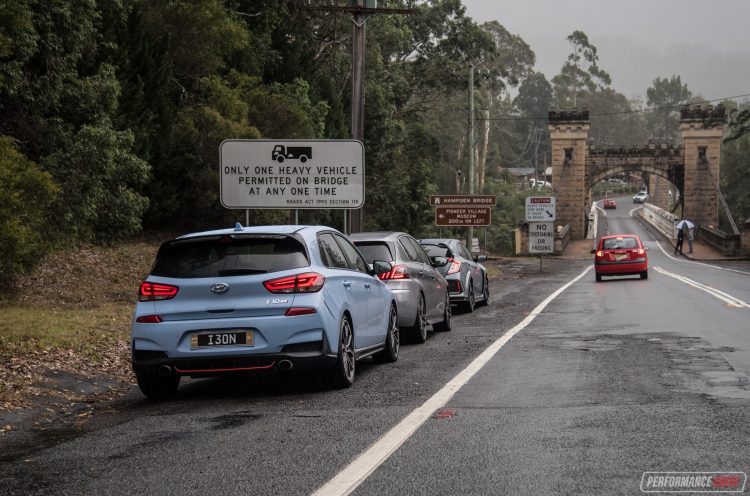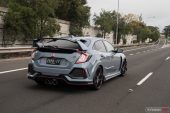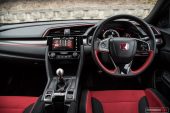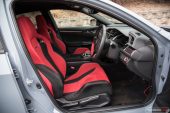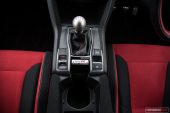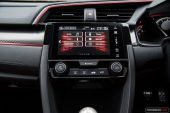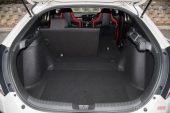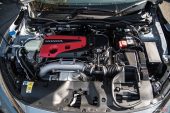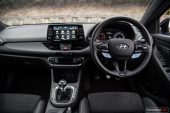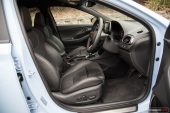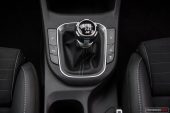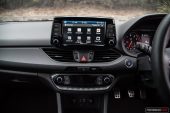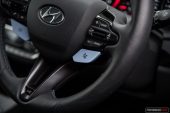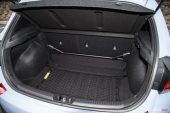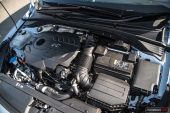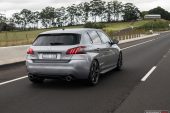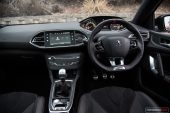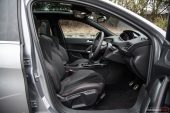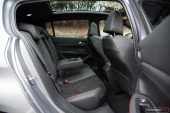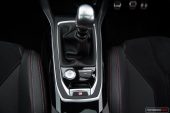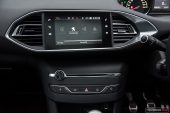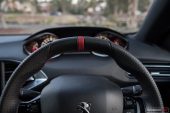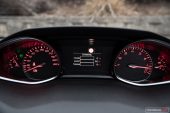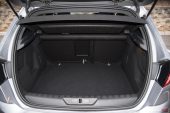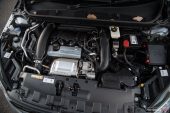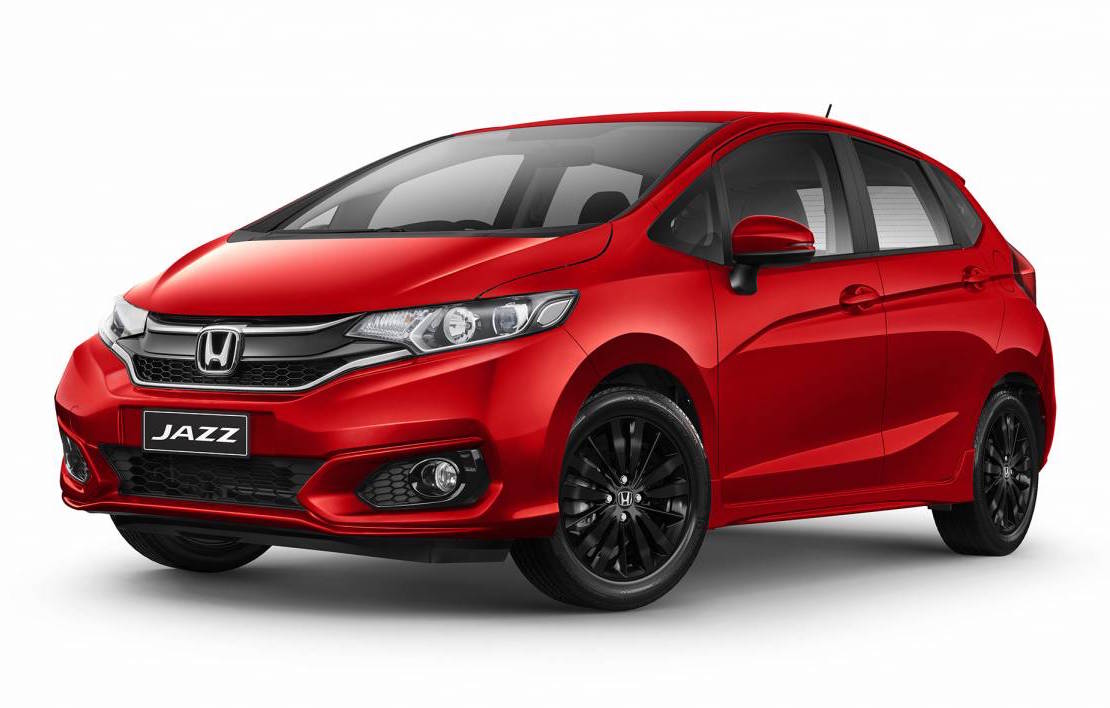| SPECS | PACKAGE | DRIVE | VERDICT |
If you’re after a very quick front-wheel drive hot hatch, you’re in luck. In fact, you’re spoiled for choice at the moment. We’ve gathered the Honda Civic Type R, the Hyundai i30 N, and the Peugeot 308 GTi together to help you figure out which one is best for you.
To get some of the housekeeping out of the way first, we’re dealing with three quite different approaches to the front-drive hot hatch formula. In alphabetical order, the Honda is built in the UK and uses a 2.0-litre turbo, promising Honda refinement with very serious track capabilities. The Hyundai is built in the Czech Republic and uses a 2.0-litre turbo, and promises LOL fun and Hyundai’s renowned practicality. And from France, the 308 GTi uses a 1.6-litre turbo, promising modern Euro design and refinement, and class-leading efficiency and lightness. All produce a similar amount of power, and all offer reasonably good practicality and economy for day-to-day driving.
Honda’s latest Civic Type R is the most expensive here, kicking off from $50,990. However, it does produce the most power and currently holds the Nurburgring lap record for a front-drive production car. Down a bit and the Peugeot 308 GTi retails from $45,990. Peugeot used to offer it in 184kW and 200kW tunes, but now it’s just the top-spec 200kW available. At the most affordable end is the new i30 N, starting from $39,990. This test model does feature the Luxury Pack, which requires an additional $3000, giving it similar levels of luxury and convenience represented in the other two.
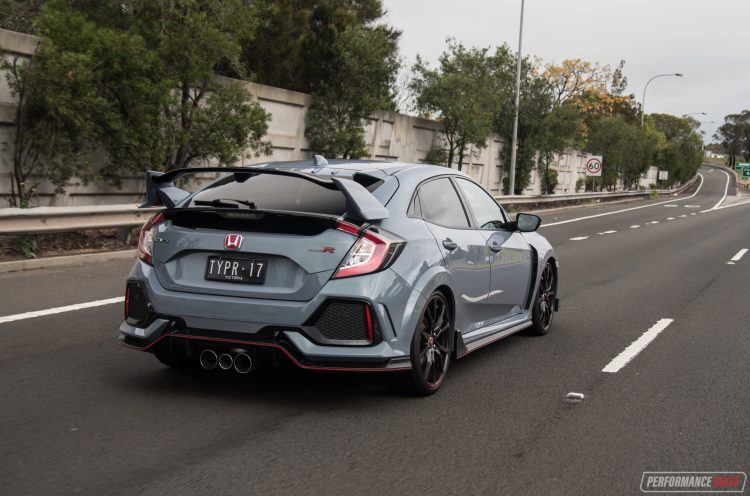
2018 Honda Civic Type R vs Hyundai i30 N vs Peugeot 308 GTi – THE SPECS
| 2018 Honda Civic Type R | Hyundai i30 N | Peugeot 308 GTi | |
|---|---|---|---|
| Engine | 2.0-litre turbo four-cylinder | 2.0-litre turbo four-cylinder | 1.6-litre turbo four-cylinder |
| Output | 228kW@6500rpm / 400Nm@2500-4500rpm | 202kW@6000rpm / 353Nm@1450-4700rpm | 200kW@6000rpm / 330Nm@1900rpm |
| Transmission | Six-speed manual | Six-speed manual | Six-speed manual |
| Drive type | Front-wheel drive, limited-slip diff | Front-wheel drive, limited-slip diff | Front-wheel drive, limited-slip diff |
| Wheels | F & R: 20×8.5, 245/30 | F & R: 19×8.0, 235/35 | F & R: 19×8.0, 235/35 |
| ANCAP | Not tested (regular Civic 5 stars) | Five stars (scored 35.01 out of 37) | Five stars |
| Tare weight | 1365kg | 1478kg | 1178kg |
| Power-to-weight | 5.98:1 (kg:kW) | 7.31:1 (kg:kW) | 5.89:1 (kg:kW) |
| Official fuel economy | 8.8L/100km | 8.0L/100km | 6.0L/100km |
| Economy during test | 9.0L/100km | 8.2L/100km | 7.8L/100km |
| Fuel capacity/type | 47L/95 RON | 50L/95 RON | 53L/95 RON |
| Power efficiency | 25.90kW:L/100km | 25.25kW:L/100km | 33.33kW:L/100km |
| 0-60km/h | 3.38 seconds* | 3.44 seconds* | 3.59 seconds* |
| 0-100km/h | 5.90 seconds* | 6.43 seconds* | 6.30 seconds* |
| 60-110km/h | 3.33 seconds* | 3.80 seconds* | 3.81 seconds* |
| 1/8 mile | 9.34 seconds at 136.4km/h* | 9.62 seconds at 132.2km/h* | 9.69 seconds at 121.8km/h* |
| 1/4 mile | 14.12 seconds at 168.8km/h* | 14.49 seconds at 163.4km/h* | 14.76 seconds at 161.2km/h* |
| Max acceleration | 0.737g | 0.815g | 0.752g |
| 100-0km/h braking | 2.92 seconds at 36.61 metres* | 2.88 seconds at 36.85 metres* | 2.89 seconds at 38.01 metres* |
| Max deceleration | -1.160g | -1.159g | -1.264g |
| Decibel at idle | 44* | 45* | 45* |
| Peak decibel at 60-100km/h | 87* | 89* | 90* |
| Priced from | $50,990 | $39,990 | $45,990 |
* Figures as tested by PerformanceDrive on the day. Factory claims may be different
2018 Honda Civic Type R vs Hyundai i30 N vs Peugeot 308 GTi – THE PACKAGE
All three of these cars come with a comprehensive touch-screen media interface. We like the Hyundai’s system the most, mainly because it is very easy to use, with separate climate controls and no hidden menus or annoying functions. The Peugeot’s system is the most interesting, with its screen fused seamlessly into the dash fascia, with a clean and almost button-free dash. This does make it less practical, though. For example, if you want to alter the climate control, you have to first select climate on the touch-screen, and then go in and make your adjustments. The graphics are nice with subtle colours and tones making it pleasing to the eye. The least favourable system is the Honda’s. Sure, the graphics are pretty crisp, but the menus are cumbersome, requiring multiple presses for simple functions, with volume buttons instead of a knob adding salt to the wound.
The Peugeot’s cabin is the warmest of the three, with soft seats, lots of suede/Alcantara trimming providing a cuddly character, and, aesthetically, the dash and console design is more pleasant and interesting compared with the Hyundai’s pretty cold yet practical theme, and the Honda’s racy arrangement with the bright red seats. Adding to the comfort, the 308’s front seats include a soothing massage function – imagine attending a track day while getting a massage during your hot laps. Peugeot has gone a bit extreme with the whole clean and uncluttered approach, in our opinion. It can be hard to find certain functions, and that tiny steering can easily obstruct the high-mounted speedometer cluster. When you select race mode, the digital speedo also disappears but you can toggle through to get it back, or check out the boost gauge (we saw up to 2.5 bar).
Sitting in the i30 N is almost like sitting in the regular i30. And that’s not a bad thing. All of the controls and buttons are placed ergonomically and are clearly marked, and the i30 is the easiest of the three to get in and out of. Sure, the front seats are nicely bolstered, but they aren’t as racy as the seats in the Honda, and the driving position feels more natural than in the 308. Being the top-line i30 means the cabin comes with all the fruit, with electric front seats when optioned with the Luxury Pack (as tested), as well as heated front seats, heated steering wheel, dual-zone climate control, and multiple connection sockets to keep devices charged.
Over in the Honda, you’ll immediate notice the space. It is the largest cabin here, especially in the back. And although the go-fast sports seats in the front are chunky, they don’t seem to sap rear legroom. The front seats are very comfortable and supportive, too. It feels like you’re constantly being hugged by a giant teddy bear. We like these seats the most out of all three, but the i30’s chairs are probably going to be more comfortable to a wider range of body types.
Boot space is also where the Honda edges ahead. There’s a clever pull-over blind to conceal your goods, instead of the usual and somewhat fidgety removeable shelf in the other two. Boot space is rated at 414L in the Honda, 381L in the Hyundai (but there is a suspension brace running across the back), and 470L in the Peugeot. Despite the Peugeot claiming a higher figure, the Honda definitely appears to offer the most useable space – there’s also the possibility that Peugeot and Honda use different measuring methods. (From top to bottom; Peugeot, Hyundai, Honda.)
Visibility is clearest in the i30, with the thinnest blind spots and the largest vista through the rear windscreen. Honda’s massive rear wing and thick C-pillars mean it does offer the least rearward visibility, but fortunately the Civic does come with Honda’s brilliant LaneWatch system. This incorporates a camera mounted in the passenger-side mirror, with the view automatically displayed on the main touch-screen, triggered when you hit the left indictor. The Peugeot sits in the middle of the three regarding visibility.
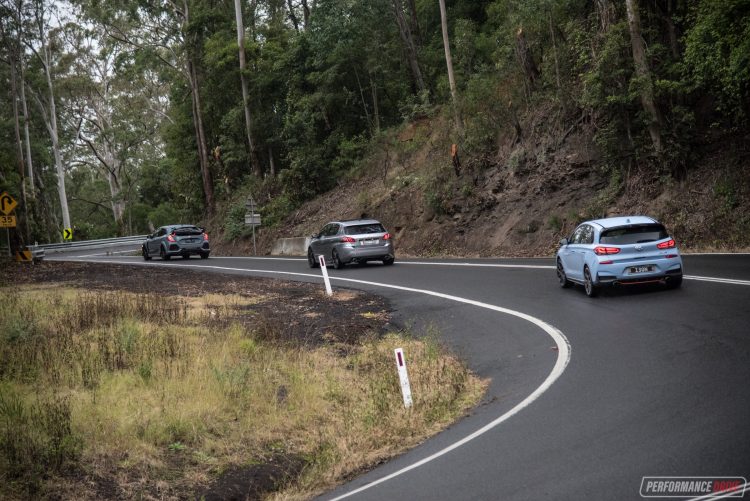
2018 Honda Civic Type R vs Hyundai i30 N vs Peugeot 308 GTi – THE DRIVE
Despite being the least powerful of the three, the Peugeot offers the best power-to-weight ratio. Weighing in at just 1178kg, it is by far the lightest here. The Honda follows, at 1365kg, and then the rather porky i30 N at 1478kg.
Across the usual sprints, we couldn’t improve on our previously tested times in the Civic Type R and i30 N (tested at Winton Raceway in sticky track conditions). However, we did manage to improve on the previous 308 GTi times. We do remember the previous test car having fairly worn out tyres, so the newer tyres probably helped this time around.
The quickest across 0-100km/h is the Civic Type R clocking it in just 5.90 seconds, followed by the 308 GTi with a new time of 6.30 seconds, and then the i30 N with its previous time of 6.43 seconds (this test saw a best of 6.51). Using launch control in the i30 N consistently resulted in slower times for us, although the system would no doubt help drivers of all experience levels enjoy some fast take-offs – and it’s pretty cool bouncing off the adjustable rev limiter. Out of the three, the i30 N is the only car with proper launch control.
Back the other way and it’s the Honda that stops in the shortest distance from 100km/h. For fairness, we’ve quoted the stopping distance we achieved on the same strip of tarmac for the i30 N, as opposed to our previous measurement of just 35m on a sticky racetrack surface. The Civic took 36.61m, with the i30 taking 36.85m, and the 308 taking 38.01m. Keep in mind these measurements don’t tell the full story as they don’t really say much about longevity and resistance to fade.
We found the i30 N’s brakes to perform best overall. After long and heated drives up and down the mountains, the Hyundai’s pedal felt exactly the same throughout, with good feel and consistent confidence. The 308 and Civic’s brakes are essentially just as impressive, with the 308’s lighter weight it means there isn’t as much strain, while the Honda uses perhaps the most hardcore arrangement, technically, with Brembo six-piston calipers up front.
Out in the mountains you’ll be surprised by how hard the little 1.6T engine pulls in the Peugeot. It might be the smallest capacity engine here but shifting the lowest weight does pay dividends. It forcefully screams up through the rev range, with very little turbo-lag when you’re really pushing it. The gears are also bunched close for a very punchy character, but the gear shift feel is the least pleasurable of this trio. All of the controls are light though, with very sharp steering amplified by a tiny steering wheel. While the handling and steering feels extremely agile in enthusiastic conditions, it can be overly busy during regular urban driving.
Hyundai has burst onto the hot hatch scene with a cracker of a car with the i30 N. Literally. It cracks and pops almost exactly like a rally car (check out the take off in our video below and you’ll see). For us, a car’s soundtrack makes up a big part of the driving experience. And the Hyundai by a long stretch wins that battle here. You just want to keep working up through the gears to enjoy the aural adventure. And unlike the Peugeot (in sport mode), there’s no fake sound coming through the speakers. It’s all about the exhaust, and the bi-modal muffler. Hyundai says the bi-modal system isn’t really ‘bi’ modal. It’s actually multi-modal, in that it constantly changes its valve opening to suit the selected driving mode and your driving bahaviour. The same philosophy is applied to the switchable rev-match system. Rev-matching can be annoying as the revs are often spiked high in some cars fitted with such technology, too high if you’re driving at 6/10ths, for example. Hyundai has tuned it so that it only dials up the amount of revs needed to sync with the wheel speed. It’s awesome. And you can turn it off if you think you’re better than it.
In the bends the Hyundai is really exciting to drive. The most exciting of these three, actually. Body composure is managed beautifully thanks to a taut suspension setting, and the front end responds to your commands quickly and without complaint or nervousness. It will kick its tail out for some lift-off oversteer if you want it to, while the others aren’t really inclined that way, even if you really provoke them. In that sense, the i30 N does feel the sportiest to drive and it tends to put the biggest smile on your face.
Honda is known for its precision engineering and build quality. In Type R models this is usually turned up a few notches. For the latest Civic Type R, almost every area of the car feels like it is made at or beyond the price it would have cost to engineer or manufacture the respective element. In that sense, the Civic actually feels like it offers the best value for money. The gear shift feel alone is something that turns us on. You can really rip through the gears, slotting them away smoothly and perfectly every time. This kind of manufacturing precision is felt throughout the car. We don’t know how Honda has made the Civic Type R so low to the ground yet provided such a plush and compliant ride. In normal or even sport mode, the Honda’s suspension, body composure, and comfort are at the top of the class. The Peugeot’s setup is quite nice too, but the front end can be wayward under full power. Hyundai’s setup is also good, with a taut and focused feel. But neither get close to the Honda for overall dynamism.
Around corners the Civic leans, braces, and slings around, pulling high g-forces in the process. And it doesn’t matter if you encounter a mid-corner bump; it’ll iron over it and continue in its intended direction. The steering is also superior in the Honda. It feels natural, mechanical and precise without being overly sensitive. On the highway it is rock-solid and stays put in the lane. Dial up the speed and pitch it into a corner and the Honda will continue this utter confidence and stability, even at crazy speeds. It is no wonder it has the Nurburgring record. About the only criticism we have with the Honda is the steering weight when you’re in R mode. It becomes very heavy and some of the feel seems to disappear.
Okay, so the Honda is the most capable here, for sure. But does that mean it’s the most fun? No. It doesn’t. Unfortunately the Honda sounds like an office building at 9pm; all you can hear is the air-conditioning humming and what sounds like an industrial-strength vacuum cleaner running somewhere over in the corner. Honda used to offer high-revving naturally aspirated engines that angrily roared up to and beyond 8000rpm. This new 2.0L turbo does come with VTEC (Honda speak for variable valve timing, as offered in all three cars), but it doesn’t rev all that high, and it certainly doesn’t roar or scream. Obviously an aftermarket exhaust would be a quick fix, and it’s something we’d probably do straight after buying the car. We guess the only good part of being so quiet is that it doesn’t attract attention on the street. Well, in terms of audio – who can overlook that crazy exterior design and massive rear wing?
Around town the Peugeot is the most pleasant to drive. The quick steering and quick gearing makes it feel very nimble and zippy, perfect for those spending lots of time in the city. While the Civic’s nose is quite low, the 308’s overhangs aren’t too bad. Meanwhile, the i30 N is similarly as practical, and you can close the exhaust somewhat for a quieter cruise. It is still the loudest though even in comfort mode.
In terms of economy, all three are quite impressive. In combined conditions the Peugeot used the least fuel for us, averaging 7.8L/100km during our week-long test, followed by the Hyundai at 8.2L/100km. The Honda used a touch more, at 9.0L/100km. We think the Honda has the potential to return similar figures in more regular conditions thanks to its high-torque engine not requiring much effort, while the Hyundai does tend to drink more when really pushing it, compared with the Peugeot. The Honda’s fuel tank capacity of 47L means it is the least expensive to fill, compared with the 50L tank in the i30 and 53L tank in the 308.
On paper, the 308’s official average of just 6.0L/100km results in a theoretical range of 883km. The Hyundai’s official consumption average of 8.0L/100km means its theoretical range is 625km from a full tank, and the Honda’s official average of 8.8L/100km results in a potential range of 534km. Overall, the 308 GTi and its 1.6 is clearly the most economical, and it tends to use the least fuel even when you’re flogging it. On the freeway the short-ratio gearbox means you need about 3000rpm to maintain 100km/h – the highest of the three. This might be something to consider if you spend most of your time on the freeway.
2018 Honda Civic Type R vs Hyundai i30 N vs Peugeot 308 GTi – THE VIDEO
2018 Honda Civic Type R vs Hyundai i30 N vs Peugeot 308 GTi – THE VERDICT
Sitting in third place it’s the Peugeot. This is the suave and stylish proposition of the hot hatch game. Its subtle design cues and smooth interior make it the least ostentatious of the three, and that holds high merit for many buyers; not everyone wants to stand out like a clown, especially when you’re simply commuting. Get it out in the mountains though and it will impress. It knows how to let its hair down and really party when the time is right. For that reason it deserves a permanent seat in the hot hatch market and it should be taken seriously if you’re coming up with a shortlist. It must be noted that it is the most fuel efficient here as well, so if you are planning on doing more commuting than doing impromptu hill climbs, then this is one you should definitely consider.
Hyundai has done an outstanding job with the i30 N. We think it meets the ‘hot hatch’ criteria better than any car here. It’s fun, above most things, yet it is very practical and can easily be driven every day. With its factory five-year/unlimited kilometre warranty providing coverage even on racing circuits, it supports the idea of having fun behind the wheel more than the others. And who can ignore that awesome exhaust note? It’s also the bargain of the crop, and comes with the longest warranty and best servicing plan.
In the end, the Honda has to take home our trophy. It is clearly the most dynamic, fastest, and best engineered vehicle not only out of these three, but in the class at the moment. It feels incredibly fast yet incredibly confident and manageable, in almost all conditions. We love the driving position and the supportive race-like seats, and the amazing ride quality despite being so low to the ground. None of this should come as a surprise though. It is the most powerful and it is the most expensive of the three.
As always, if you’re thinking about buying a new car don’t forget to click here to speak with our car buying specialists.
